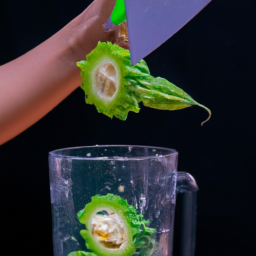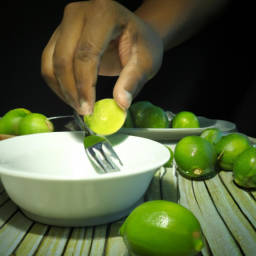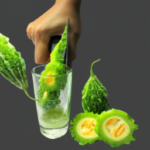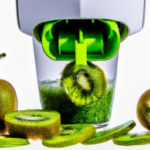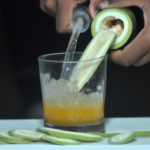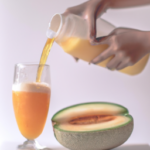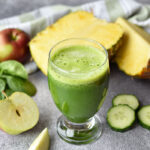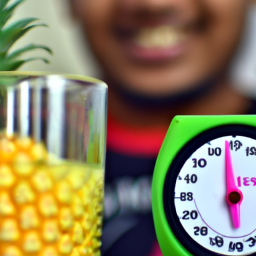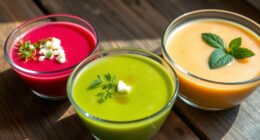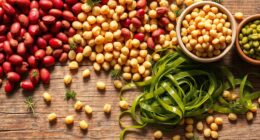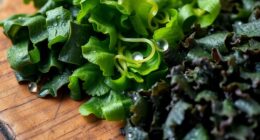Making your own bitter melon juice at home is a great way to incorporate this unique and nutritious fruit into your diet. Also known as bitter gourd or karela, bitter melon is a tropical fruit that is commonly used in Asian, African, and Caribbean cuisines for its distinct bitter taste and numerous health benefits.
While some may find its taste challenging, bitter melon is packed with vitamins, minerals, and antioxidants that can help improve digestion, lower blood sugar levels, and boost immunity.
In this article, I will guide you through the process of making bitter melon juice from start to finish. I will cover everything from selecting the freshest bitter melons to choosing the right juicer and adding other ingredients to enhance the flavor and nutrition of your juice.
Whether you are new to bitter melon or a seasoned fan, this guide will provide you with all the information you need to make delicious and nutritious bitter melon juice at home.
Key Takeaways
- Choose ripe bitter melons that are firm and have a vibrant green color, avoiding blemishes and soft spots.
- Slice the bitter melon in half lengthwise, scrape out the insides, and rinse under running water to remove any remaining seeds or pith.
- Use a masticating juicer to extract more juice and retain more nutrients, and mix with other fruits or vegetables to balance out the flavor.
- Bitter melon juice has a short shelf life and should be consumed within 2-3 days.
Selecting Fresh Bitter Melons
If you’re looking to make the perfect bitter melon juice, you’ll want to start by picking out the freshest and brightest bitter melons you can find! The key to selecting ripe bitter melons is to look for ones that are firm to the touch and have a vibrant green color. Avoid bitter melons with blemishes or soft spots, as these indicate that the fruit may be overripe or starting to spoil.
When selecting bitter melons, it’s also important to consider the size and shape of the fruit. Generally, smaller bitter melons are less bitter than larger ones, and rounder bitter melons are sweeter than more oblong ones.
Keep in mind that bitter melons do have a naturally bitter taste, so even with the freshest and best-quality fruit, some bitterness is to be expected. With that said, selecting the best possible bitter melons will definitely help to ensure a more enjoyable and flavorful juice.
Once you’ve selected your bitter melons, the next step is to prepare them for juicing.
Preparing Bitter Melons for Juicing
First, slice the bitter melon in half lengthwise, revealing the seeds and white pith. Use a spoon or knife to scrape out the insides, making sure to remove all the seeds and as much of the pith as possible. The pith is where most of the bitterness resides, so removing it will help reduce the overall bitterness of the juice.
Next, rinse the bitter melon halves under running water to remove any remaining seeds or pith. Then, cut the halves into smaller pieces that will fit into your juicer.
There are various cleaning techniques that can be used to reduce bitterness, such as soaking the pieces in salt water or blanching them in boiling water before juicing. However, these methods may also remove some of the nutrients.
It’s ultimately up to personal preference whether to use these techniques or not. With the bitter melon prepared, it’s time to move on to choosing a juicer.
Choosing a Juicer
When selecting a juicer, it’s essential to consider the type of produce you’ll be juicing and the level of nutrient extraction you desire. There are two main juicing techniques: centrifugal and masticating. Centrifugal juicers work by spinning a blade at high speeds to extract juice from the produce, while masticating juicers use a slow, grinding motion to extract juice. Centrifugal juicers are generally less expensive and faster, but they may not extract as much juice or retain as many nutrients as masticating juicers.
To get the most out of your bitter melon juice, it’s recommended to use a masticating juicer. These juicers tend to be more expensive, but they extract more juice and retain more nutrients than centrifugal juicers. When choosing a juicer, it’s also important to consider how easy it is to clean. Look for a juicer with removable parts that can be easily washed and a cleaning brush included. With the right juicer, you can easily make fresh, nutrient-rich bitter melon juice at home.
Now that you’ve chosen the right juicer, it’s time to start juicing the bitter melons.
Juicing the Bitter Melons
Congratulations, you’ve finally decided to unleash the power of this spiky green fruit and turn it into a delicious and nutritious elixir! Juicing bitter melons can be a bit tricky, as their strong flavor can be overwhelming for some. However, with the right juicing techniques and bitterness management, you can create a refreshing and healthy drink that will leave you feeling energized.
To start, begin by washing your bitter melons thoroughly and slicing them into smaller pieces that will fit into your juicer. You can also remove the seeds if you prefer a smoother consistency. It’s important to note that bitter melons are, well, bitter, so it’s recommended to mix them with other fruits or vegetables to balance out the flavor. Some popular choices include apples, carrots, and cucumbers.
Experiment with different combinations until you find your favorite. Finally, juice the bitter melon pieces and your chosen fruits/vegetables together, and voila! You have a delicious and nutrient-packed drink.
Moving onto adding other ingredients, you can also try adding some ginger or lemon for an extra kick of flavor and health benefits. These ingredients can help with digestion and enhance the overall taste of the juice.
Remember to always use fresh ingredients and drink the juice immediately after juicing for maximum health benefits.
Now that you have learned how to juice bitter melons, let’s move on to exploring the different flavors you can create by adding other ingredients.
Adding Other Ingredients
Get ready to take your bitter melon juice to the next level by adding in some exciting new ingredients! Bitter melon juice on its own can be quite intense, but by incorporating some flavor combinations, you can make it more palatable and enjoyable to drink.
Here are some ideas to get you started:
-
Ginger: Adding fresh ginger to your bitter melon juice can give it a spicy kick and help to mask some of the bitterness. Ginger also has anti-inflammatory properties and can aid in digestion.
-
Lemon: Squeezing some fresh lemon juice into your bitter melon juice can add a tangy flavor and provide a boost of vitamin C. Lemon is also known to have detoxifying properties.
-
Honey: A drizzle of honey can help to sweeten up your bitter melon juice without adding any refined sugar. Honey is also a natural anti-inflammatory and can help to soothe a sore throat.
In addition to adding flavor, these ingredients also offer various nutritional benefits that can boost your overall health. Experiment with different combinations to find the one that works best for you.
Now that your bitter melon juice is all mixed up, it’s time to learn about the best ways to store it to ensure maximum freshness and flavor.
Storing Bitter Melon Juice
To keep your freshly prepared bitter melon juice at its best, you’ll want to store it in an airtight container and place it in the refrigerator. This will help preserve the freshness and prevent bacterial growth. It is important to note that bitter melon juice has a short shelf life and should be consumed within 2-3 days of preparation to ensure the best taste and nutritional value.
One tip for preserving bitter melon juice freshness is to add a small amount of lemon juice to the mixture. Lemon juice is a natural preservative and can help extend the shelf life of the juice.
Another tip is to avoid adding any sweeteners or other ingredients that may cause the juice to spoil faster. By following these tips, you can enjoy the full benefits of bitter melon juice for a longer period of time.
Drinking bitter melon juice has numerous health benefits, including aiding in digestion and regulating blood sugar levels.
Health Benefits of Bitter Melon Juice
Now that we’ve discussed how to store bitter melon juice, let’s move on to its health benefits.
Bitter melon is a rich source of vitamins and minerals, including vitamin C, vitamin A, potassium, and iron. Drinking bitter melon juice regularly can help boost your immune system, improve digestion, and keep your skin healthy.
But what makes bitter melon juice stand out is its potential to help manage diabetes. Studies have shown that bitter melon juice can help improve blood sugar control in people with type 2 diabetes. Some research even suggests that it may have a similar effect to certain diabetes medications. This is because bitter melon contains compounds that help increase insulin sensitivity, which allows the body to use glucose more effectively. However, it’s important to note that more research is needed to fully understand the effects of bitter melon on diabetes.
Moving on, it’s important to be aware of certain precautions and potential side effects when consuming bitter melon juice.
Precautions and Side Effects
Before incorporating bitter melon juice into my diet, I decided to conduct some research on its potential side effects.
I discovered that hypoglycemia is a possible risk, as bitter melon can lower blood sugar levels. Additionally, some people may experience gastrointestinal issues such as diarrhea or abdominal pain after consuming bitter melon.
Lastly, allergic reactions to bitter melon have also been reported. It’s important to be aware of these potential side effects before consuming bitter melon juice.
Hypoglycemia
If you’re looking for a natural way to regulate your blood sugar levels, bitter melon juice might be just what you need. Hypoglycemia is a condition where blood sugar levels drop below normal, which can cause symptoms such as dizziness, confusion, and sweating.
Causes of hypoglycemia can range from medication side effects to underlying health conditions, and managing hypoglycemia through diet is one way to help prevent these symptoms.
Here are three ways that bitter melon juice can help manage hypoglycemia through diet:
-
Bitter melon contains compounds that have been shown to lower blood sugar levels. These compounds, called charantin and polypeptide-p, work by increasing the uptake of glucose into cells and improving insulin sensitivity.
-
Drinking bitter melon juice before meals can help slow down the absorption of carbohydrates, which can prevent sudden spikes in blood sugar levels.
-
Bitter melon juice is low in calories and carbohydrates, making it a healthy addition to a balanced diet for those with hypoglycemia.
As with any dietary changes, it’s important to talk to your doctor before adding bitter melon juice to your regimen.
In the next section, we’ll discuss how bitter melon juice can also cause gastrointestinal issues if consumed in excess.
Gastrointestinal Issues
Consuming excessive amounts of bitter melon can lead to digestive problems, such as stomach cramps and diarrhea. This is because bitter melon contains compounds that can irritate the gastrointestinal tract.
However, moderate consumption of bitter melon has been shown to have beneficial effects on the digestive system, such as improving digestion and reducing inflammation.
The causes of gastrointestinal issues vary, but they can be triggered by a number of factors such as stress, food intolerances, and infections. Natural remedies for GI issues include consuming foods that are rich in fiber, probiotics, and anti-inflammatory compounds. Bitter melon is one such food that can help improve digestive health when consumed in moderation.
However, if you experience persistent gastrointestinal symptoms after consuming bitter melon, it’s important to seek medical attention to rule out any underlying conditions.
Moving on to the next topic, allergic reactions to bitter melon can occur in some individuals.
Allergic Reactions
You may be surprised to learn that bitter melon could be hiding a potentially dangerous secret – allergic reactions. While the fruit is known for its medicinal properties and health benefits, it’s important to be aware of the possibility of allergic reactions. Some people may be allergic to bitter melon juice due to its protein content, which can cause an immune system response.
Common triggers of allergic reactions include itching, hives, swelling, abdominal pain, and difficulty breathing. If you experience an allergic reaction to bitter melon juice, it’s important to seek medical attention immediately. Treatment options for allergic reactions vary depending on the severity of the reaction. Mild reactions can be treated with antihistamines, while more severe reactions may require epinephrine injections.
It’s also important to be aware of cross reactivity, as individuals who are allergic to other fruits and vegetables in the same family, such as cucumbers and zucchinis, may also be allergic to bitter melon juice. Incorporating bitter melon juice into your diet can be a great way to take advantage of its health benefits, but it’s important to be aware of the potential for allergic reactions.
If you’ve never tried bitter melon juice before, it’s recommended to start with a small amount and gradually increase your intake. Be sure to monitor your body’s response and seek medical attention if you experience any symptoms of an allergic reaction.
Incorporating Bitter Melon Juice into Your Diet
Incorporating bitter melon juice into your daily routine can be a smart choice for those looking to enhance their diet with a wealth of health benefits. Bitter melon is a nutrient-dense vegetable that’s rich in vitamins A, C, and K, as well as minerals like potassium, calcium, and iron. Additionally, bitter melon contains compounds like charantin and momordicin, which have been shown to have anti-diabetic properties and can help regulate blood sugar levels.
If you’re looking to try bitter melon juice, there are several ways to incorporate it into your diet. Here are two sub-lists to get you started:
-
Drink it plain: Bitter melon juice can be consumed on its own as a daily health tonic. Start with a small amount and gradually increase your intake to avoid any digestive discomfort.
-
Mix it with other juices: If you find the taste of bitter melon juice too strong, try mixing it with other juices like apple, carrot, or lemon to balance out the bitterness.
-
Add it to smoothies: Bitter melon juice can also be added to smoothies along with other fruits and vegetables for a nutrient-packed breakfast or snack.
-
Use it in cooking: Bitter melon juice can be used as a marinade for meats or added to stir-fry dishes for a tangy, bitter flavor.
Incorporating bitter melon juice into your diet is a simple way to reap the many benefits of this superfood. With its anti-diabetic properties and high nutrient content, bitter melon juice can help regulate blood sugar levels and support overall health and wellness.
Frequently Asked Questions
How often should I drink bitter melon juice to reap its health benefits?
To reap the health benefits of bitter melon, I drink 1/2 cup of juice daily. However, be mindful of the dosage, as too much can cause side effects. Precautions include consulting a doctor if taking medication or pregnant.
Can I use frozen bitter melon instead of fresh bitter melon for juicing?
I have found that frozen bitter melon can be used for juicing, but the taste may differ from fresh bitter melon. It is recommended to thaw the bitter melon before juicing to ensure a smoother consistency.
What is the ideal time of day to drink bitter melon juice?
As the saying goes, "early to bed and early to rise makes a man healthy, wealthy, and wise."Drinking bitter melon juice in the morning on an empty stomach is the ideal timing for maximum health benefits. Studies suggest it can improve blood sugar levels and boost immunity.
Are there any special cleaning instructions for my juicer after juicing bitter melons?
To prevent bitterness, clean your juicer thoroughly after juicing bitter melons. Disassemble the parts and soak them in warm, soapy water for 15-20 minutes before rinsing and drying.
Can I mix bitter melon juice with other juices to improve its taste?
Mixing juices is a great way to enhance the taste of bitter melon juice. I like to add apple or carrot juice to balance the bitterness. It’s important to experiment with different combinations to find what works best for you.
Conclusion
Well, that’s all there’s to it! Making bitter melon juice is simple and straightforward, and the health benefits are undeniable. Whether you’re looking to improve your digestion, boost your immune system, or regulate your blood sugar levels, bitter melon juice is an excellent addition to your diet.
As with any new food or supplement, it’s important to start slowly and pay attention to how your body reacts. Some people may experience mild side effects, but these can usually be avoided by sticking to moderate amounts and taking breaks as needed.
Overall, bitter melon juice is a powerful and nutritious drink that can help you feel your best. So why not give it a try and see what it can do for you?
Using a rhetorical question, I ask the audience to consider the benefits of trying bitter melon juice and to take a chance on incorporating it into their daily routine.
Ilana has been a vegan for over 10 years. She originally made the switch for health reasons, but soon found herself becoming more and more passionate about the ethical and environmental implications of a vegan lifestyle. Ilana is the author of The Graceful Kitchen, a blog all about veganism. She loves to cook up delicious and nutritious vegan meals, and share her recipes with others who are interested in leading a cruelty-free life. Ilana is also a strong advocate for using whole foods as the foundation of a healthy diet, and believes that going vegan is one of the best ways to achieve this.
